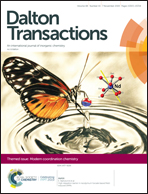Heterometallic 3d–4d coordination polymers assembled from trans-[RuIII(L)(CN)2]− tectons and 3d cations†
Abstract
Five new cyanido-bridged heterometallic coordination polymers have been obtained by reacting PPh4[RuIII(salpn)(CN)2]·H2O (1) and AsPh4[RuIII(valen)(CN)2]·8.5H2O (2) (H2salpn and H2valen being Schiff-base proligands resulting from the condensation reaction of salicylaldehyde with 1,3-propanediamine and, respectively, o-vanillin with 1,2-ethanediamine) with divalent transition metal perchlorate salts: ∞1[{RuIII(salpn)(CN)2}3{MII(DMF)3}2](ClO4)·4DMF (MII = Mn, 3; Co, 4) and ∞2[{RuIII(valen)(CN)2}4{MII(DMF)3}2{MII(DMF)4}](ClO4)2·4DMF (MII = Mn, 5; Co, 6; Ni, 7), respectively. The dicyanido species, trans-[Ru(salpn)(CN)2]− and trans-[Ru(valen)(CN)2]−, act as metalloligands with the 3d metal ions. Compounds 3 and 4 are isostructural one-dimensional (1D) coordination polymers with a ladder topology. Each MII ion is hexacoordinated by three cyanido groups arising from three {Ru(salpn)(CN)2} units and by the oxygen atoms from three DMF molecules, which are coordinated at meridional positions. Compounds 5–7 are also isostructural, their structures consisting of 2D networks with a herringbone topology. The magnetic susceptibility measurements of these 1D and 2D systems reveal the presence of dominating RuIII–MII antiferromagnetic (AF) interactions in compounds 3, 4, 5 and 6, while ferromagnetic RuIII–NiII interactions are observed in 7. All these compounds stay in their paramagnetic state down to 1.8 K except compound 4 which possesses a 3D ordered AF ground state.
![Graphical abstract: Heterometallic 3d–4d coordination polymers assembled from trans-[RuIII(L)(CN)2]− tectons and 3d cations](/en/Image/Get?imageInfo.ImageType=GA&imageInfo.ImageIdentifier.ManuscriptID=C9DT01593K&imageInfo.ImageIdentifier.Year=2019)
- This article is part of the themed collection: Modern coordination chemistry


 Please wait while we load your content...
Please wait while we load your content...